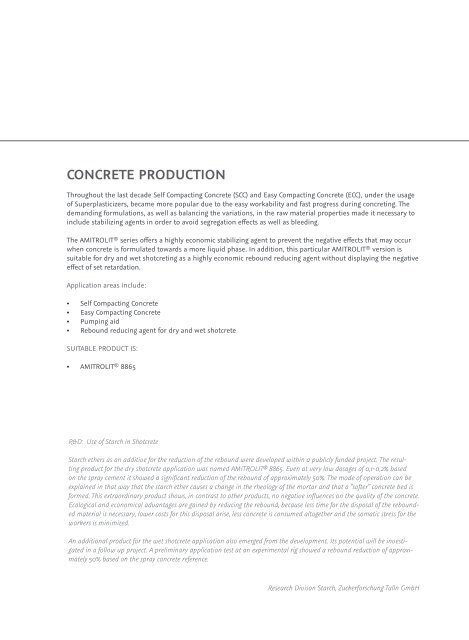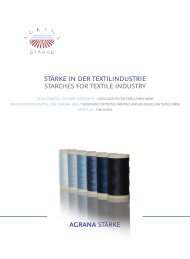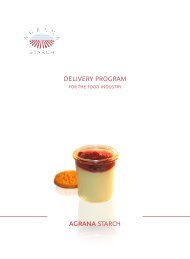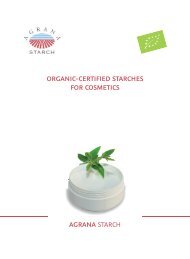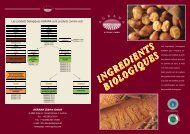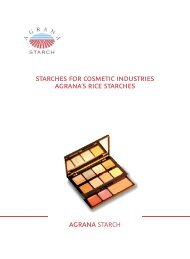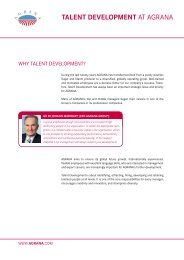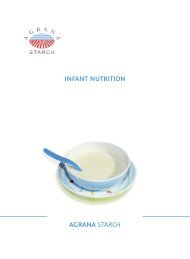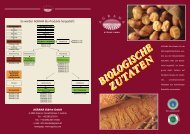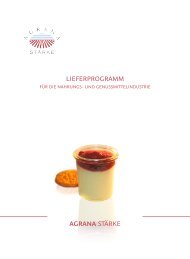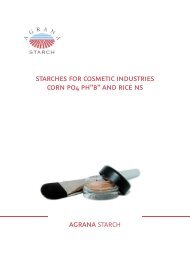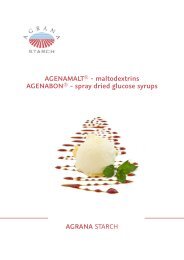AGRANA STARCH AGRANA STARCH CONSTRUCTION ...
AGRANA STARCH AGRANA STARCH CONSTRUCTION ...
AGRANA STARCH AGRANA STARCH CONSTRUCTION ...
Create successful ePaper yourself
Turn your PDF publications into a flip-book with our unique Google optimized e-Paper software.
CONCRETE PRODUCTION<br />
Throughout the last decade Self Compacting Concrete (SCC) and Easy Compacting Concrete (ECC), under the usage<br />
of Superplasticizers, became more popular due to the easy workability and fast progress during concreting. The<br />
demanding formulations, as well as balancing the variations, in the raw material properties made it necessary to<br />
include stabilizing agents in order to avoid segregation effects as well as bleeding.<br />
The AMITROLIT ® series offers a highly economic stabilizing agent to prevent the negative effects that may occur<br />
when concrete is formulated towards a more liquid phase. In addition, this particular AMITROLIT ® version is<br />
suitable for dry and wet shotcreting as a highly economic rebound reducing agent without displaying the negative<br />
effect of set retardation.<br />
Application areas include:<br />
• Self Compacting Concrete<br />
• Easy Compacting Concrete<br />
• Pumping aid<br />
• Rebound reducing agent for dry and wet shotcrete<br />
SUITABLE PRODUCT IS:<br />
• AMITROLIT ® 8865<br />
R&D: Use of Starch in Shotcrete<br />
Starch ethers as an additive for the reduction of the rebound were developed within a publicly funded project. The resulting<br />
product for the dry shotcrete application was named AMITROLIT ® 8865. Even at very low dosages of 0,1-0,2% based<br />
on the spray cement it showed a significant reduction of the rebound of approximately 50%. The mode of operation can be<br />
explained in that way that the starch ether causes a change in the rheology of the mortar and that a “softer” concrete bed is<br />
formed. This extraordinary product shows, in contrast to other products, no negative influences on the quality of the concrete.<br />
Ecological and economical advantages are gained by reducing the rebound, because less time for the disposal of the rebounded<br />
material is necessary, lower costs for this disposal arise, less concrete is consumed altogether and the somatic stress for the<br />
workers is minimized.<br />
An additional product for the wet shotcrete application also emerged from the development. Its potential will be investigated<br />
in a follow up project. A preliminary application test at an experimental rig showed a rebound reduction of approximately<br />
50% based on the spray concrete reference.<br />
Research Divison Starch, Zuckerforschung Tulln GmbH


